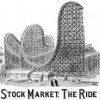We see a run to the 1929-esque peak of 2,800 for the S&P 500 as a possibility and a bubble of that magnitude would likely be followed by a Newtonian reaction and we could see a crash that would lead to the scenario we outlined above… and a bubble of that magnitude would likely be followed by a Newtonian reaction and we could see a crash that would lead to the scenario we outlined above… The comments above & below are edited ([ ]) and abridged (?) excerpts from the original article by Mark Yuskos (MorganCreekCap.com) ?Probably no nation in modern times has suffered so frequently or so greatly as the United States from recurrent periods of exaggerated optimism and unrealistic interpretation of its economic situation. This tendency to ignore the natural law of steady growth has its deep roots in American history and the American temperament. The country was discovered, settled, and developed by speculators and adventurers, and not so long ago but that the strain is still in the blood of American business and the general public.? Virgil Jordan from the January 1930 issue of The North American Review [Sound familiar here in March/April of 2017?] In the fall of 1927 the DJIA had just breached 200 after having doubled over the previous three years. Money was pouring into the equity markets…and prices were beginning to move materially above fair value…A year later, the Dow had rallied another 30% to 260 as Herbert Hoover was elected president but, as equity bubbles go, the euphoria stage was just about to begin. The average investor had bought into Hoover's promises of prosperity in a big way and the 1929 stock market started out ?hot? with the DJIA rising 5.6% in January (investors were slightly less ebullient in Trump's first month, but the S&P 500 was still up nicely, rising 1.9%, while NASDAQ was more Hooverish, up 4.3%). The Hoover Bubble took a pause in February and March, flat and down (2.5%), to finish Q1 up a solid 3%. The climb resumed in April with markets rallying 3.2%, but then there was the first tremor of what was to come later as equities dropped (6%) in May to where they began the year, only to have the original ?Buy the Dippers? come out in force in June and the markets rocketed up 12.4% to finish Q2 up a robust 8.1%. The crescendo was still to come as the Dow jumped another 4.2% in July and the final thrust upwards of 9.2% in August to arrive at Labor Day up 27%…The DJIA peaked at 381.17 a couple days later on September 3rd and newspaper headlines read, ?Public Demand for Stock Appears Insatiable.? The rest, as they say, is history. The index did not regain that level for 25 years. It took two and a half decades to get back to even. Over the next couple of days, stocks began to decline and had fallen (2.9%) by September 5th (not that big a deal given the March and May volatility and the huge run up in the previous few months) and this is where our hero enters the story. Roger Ward Babson, born on July 6, 1875 in Gloucester, Massachusetts. delivered his now famous speech to the National Business Conference where he said, ?I repeat what I said at this time last year and the year before, that sooner or later a crash is coming which will take down the leading stocks and cause a decline of 60 to 80 points in the Dow Jones Barometer. Fair weather cannot always continue. - The Economic Cycle is in progress today as it was in the past.
- The Federal Reserve System has put the banks in a strong position, but it has not changed human nature.
- More people are borrowing and speculating today than ever in our history.
- Sooner or later a crash is coming and it may be terrific.
- Wise are those investors who now get out of debt and reef their sails. This does not mean selling all you have, but it does mean paying up your loans and avoiding margin speculation.
- Sooner or later the stock market boom will collapse like the Florida boom. Some day…the market will begin to slide off, sellers will exceed buyers, and paper profits will begin to disappear. Then there will immediately be a stampede to save what paper profits then exist.?
As news of his prediction reached Wall Street, the markets fell another (3%) and that decline was later labeled the ?Babson Break? and fell (9.7%) in September and that little recession in stock prices had begun. On October 13th, Dr. Charles Amos Dice, a professor of business at Ohio State University, said that the market rally was just getting started, ?The stock market will see bigger gains in the immediate future than at any other period of its history, and except for minor fluctuations the present high level of prices will be constant for years to come.? Given the massive increase in equity prices over the past few years, this seemed like an inopportune time to make such a bold prediction, but these are often the types of things you hear near market tops. Who can forget the book Dow 36,000, published months before the 2000 peak with DJIA at 16,000, a level it would not regain for fourteen years? When ?Black Thursday? came on October 24th and the stock market bubble finally burst for good, it was a horror show. It fell another 9% over the next week to finish October at 273. Babson had claimed that stocks could crash: - in 1927 and they had nearly doubled over the past two years, so he was clearly wrong.
- In 1928 and they had rallied nearly 35% in the past year, so he was clearly wrong.
- Now Babson was claiming that stocks could crash and they were only down (10.5%), which is nothing but a speed bump on the permanently higher plateau, so he was definitely wrong…
Does the fact that when all was said and done the DJIA fell to 41 by July 1932, a total loss of (89%) from the peak, and even (80%) lower than the level at Babson's first warning, mean that he was right? This is the toughest question in investing. When is 'early' the euphemism for 'wrong'? - Is it okay to miss out on the last 150% of gains over the final two years of the Bubble in cash to have a $1.00 at the end of five years rather than $0.11?
- If you were managing other people's money, could you keep your clients while you sat on the sidelines in cash while everyone else was getting rich? Likely easier said than done.
The real issue here is that the events are not directly related, Babson being wrong in 1927 and 1928 doesn't change the facts at the time in 1929. Just because the markets went to more extreme levels than he thought was possible given fundamentals in the prior two years doesn't change the fact that the call for caution in 1929 was excellent advice and that the risk/ reward was skewed very much to the downside. We will go out on a limb here and say Roger Babson wasn't wrong or even early, but was actually right all along. The crash came and it was beyond terrific, it was horrific. Fortunes were lost, businesses were destroyed, thousands of banks collapsed and disappeared (taking depositors' savings with them) and, after a series of policy errors by Hoover, the Republican Congress and the Fed, the 1929 Recession morphed into the Great Depression. …The stock market and the economy were not independent as Hoover had suggested, but rather they spiraled downwards together for many years, wringing out the excesses that had been built up during the Roaring Twenties. Newton was right. For every action, there is an equal and opposite reaction, and the symmetry of the rise and fall is a chart pattern that every student of financial history knows all too well. So what is the primary message to take away from all of this history and discussion of Roger Babson?…Babson's brilliance was his ability to consistently stick to his discipline and remain cautious and defensive, even in the face of ridicule from the media and loss of clients who were tiring of the proverbial boy who cried wolf about the dangers of the stock markets (while all their friends were getting rich?temporarily it turned out). Now it is time to step way out onto a limb and remind you that we have been warning that a correction could come since the summer of 2015… and to paraphrase Mr. Babson, we repeat what we said last summer, and the summer before, that a correction is coming and it might be terrific. …We have made the case over the past year that the S&P 500 could run toward the Jeremy Grantham 2,300 and that would trigger a #2000.2.0 correction (down (40%) over three years), but we are now modifying that view. We see a run to the 1929-esque peak of 2,800 as a possibility and a bubble of that magnitude would likely be followed by a Newtonian reaction and we could see a crash that would lead to the scenario we outlined above… We don't have a crystal ball, but we are students of history and we do agree with Churchill that, ?the farther back you can look, the farther forward you are likely to see,? and by looking back nearly a century, we believe we have a fairly clear picture of what could happen if things do begin to spiral out of hand. Win An iPad Pro! TalkMarkets.com is so convinced you'll love their website they are raffling off an iPad Pro to those who registers here by June 30, 2017. For more information please read the contest Terms and Conditions.975 authors contribute to TalkMarkets.com so check it out, register here and then program the site to provide you with exactly what you want by topic and author.If you want more articles like the one above: LIKE us on Facebook; ?Follow the munKNEE? on Twitter or register to receive our FREE tri-weekly newsletter (see sample here , sign up in top right hand corner).
The post Has the U.S. Gone Stock Market Mad? Here's What Happened Leading Up to 1929 & Beyond appeared first on munKNEE dot.com. |

